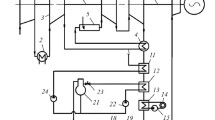The problem of performing deep unloading of power units is of great importance for power systems operated by PJSC Mosénergo and other companies, especially when taking into account the significant difference in electricity prices during the day and at night. As a rule, power units equipped with T-250-240 UTZ thermal steam turbines are arranged as boiler-turbine monoblocks, whose thermal start-up scheme is single-bypass. Here, fresh high-pressure steam is discharged directly into the condenser through the HP bypass, while steam removal following intermediate overheating is carried out directly in front of the intermediate pressure stop valve (IPSV) through a pipeline with shut-off valves. Since a combined sliding steam pressure is used when these power units operate under load, the unloading of the power unit comprises two stages: initial unloading to 80 – 85% nominal capacity at the nominal pressure of fresh steam and subsequent unloading of the unit to the technological minimum load at the sliding pressure of fresh steam with partially-open regulating control valves of the steam turbine HP (determined by the angle of rotation of the cam shaft at the level of 75 – 80°). With a turbine power of 120 MW and a sliding steam pressure of HP, the steam pressure in the selection will be about 1.2 – 1.4 MPa, which allows the use of a block steam collector to power the turbo drive of the feed pump at a lower steam temperature in the collector (250 – 280°C). At low loads, unloading of the unit can be carried out without switching to boiler power from a feeding electric pump. The safety of the equipment is ensured due to the presence of a regulating diaphragm that prevents the acceleration of the turbine rotor in the closed state. The turbo drive is powered by steam from the third selection of the turbine at high block loads of 100 – 120 MW; that is, when the power unit is unloaded, the feed water pump power supply scheme does not change. The hydraulic properties of the furnace walls have an unambiguous characteristic in the working area, which confirms their aperiodic stability, in particular, by tests carried out on the walls of the lower (LRS-I, LRS-II), intermediate (IRS) and upper (URS) radiant sections of the boiler in the load range up to 45% of nominal boiler capacity. Thermohydraulic maldistribution in the boiler heating surfaces does not exceed standard values to ensure reliable circulation during unloading of the power unit up to 40% of the rated capacity. Temperature fluctuations and irregularities in the distribution of the steam-water mixture in the panel of the middle radiation part have the maximum permissible values. Analysis of the temperature regime of the metal pipes of the lower and upper radiation part of the boiler showed that the temperature of the outer surface of the expanded pipe made of 12X1MF steel does not exceed 476°C, which provides a reliable temperature regime at the maximum permissible temperature of 570°C from the condition of sufficient margin for mechanical strength.
Similar content being viewed by others
References
RD 34.25.107 (SO 153-34.25.107). Technical Requirements for Maneuverability of Power Units of Thermal Power Plants with Condensing Turbines [in Russian], SPO STE, Moscow (1987).
Yu. A. Radin, V. I. Gombolevskii, B. N. Nosov, V. I. Plachkov, and N. P. Danilenko, “Analysis of start-up modes of 250 MW cogeneration unit with external steam supply to the feed turbine pump,” Élektr. Stantsii, No. 6, 12 – 15 (2000).
Thermal Design of Boilers (Standard method) [in Russian], NPO TsKTI, St. Petersburg (1998).
O. M. Baldina, V. A. Lokshin, D. F. Peterson, I. E. Semenovker, and A. L. Shvarts, Hydraulic Design of Boilers (Standard Method) [in Russian], Énergiya, Moscow (1978).
Technological Maintenance of Unloading of 250 – 300 MW Power Units on Sliding Pressure in the Whole Steam-Veam Circuit with TGMP-314P and TGMP-344A Boilers at Mosénergo TPP in the Allowed Load Range [in Russian], RAO EES Rossii, OAO Firma ORGRÉS, Moscow (1997).
State Standard GOST R 50831-95M. Boiler Plants. Heat-Mechanical Equipment. General Technical Requirements [in Russian], Izd. standartov, Moscow (1996).
SO 34.26.718. Procedure Guidelines for Testing of Hydraulic Stability of Continuous-Flow Power and Hot-Water Boilers [in Russian], SPO STÉÉ, Moscow (1983).
Author information
Authors and Affiliations
Corresponding author
Additional information
Translated from Élektricheskie Stantsii, No. 9, September 2022, pp. 16 – 21. DOI: https://doi.org/10.34831/EP.2022.1094.9.003
Rights and permissions
Springer Nature or its licensor (e.g. a society or other partner) holds exclusive rights to this article under a publishing agreement with the author(s) or other rightsholder(s); author self-archiving of the accepted manuscript version of this article is solely governed by the terms of such publishing agreement and applicable law.
About this article
Cite this article
Lenev, S.N., Moskvin, K.V., Radin, Y.A. et al. On the Issue of Unloading Supercritical Steam Pressure Units Used in T-250/300-240 Cogeneration Steam Turbines. Power Technol Eng 56, 883–888 (2023). https://doi.org/10.1007/s10749-023-01605-w
Published:
Issue Date:
DOI: https://doi.org/10.1007/s10749-023-01605-w



